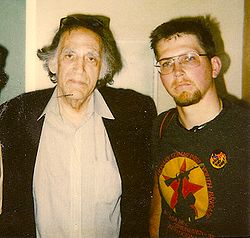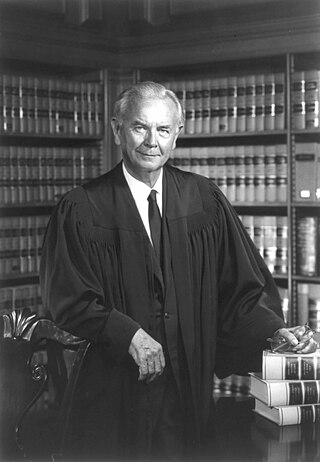
William "Bill" Joseph Brennan Jr. was an American lawyer and jurist who served as an Associate Justice of the Supreme Court of the United States from 1956 to 1990. He was the seventh-longest serving justice in Supreme Court history, and known for being a leader of the U.S. Supreme Court's liberal wing.
United States v. Eichman, 496 U.S. 310 (1990), was a United States Supreme Court case that invalidated a federal law against flag desecration as a violation of free speech under the First Amendment. It was argued together with the case United States v. Haggerty. It built on the opinion handed down in the Court's decision the prior year in Texas v. Johnson (1989), which invalidated on First Amendment grounds a Texas state statute banning flag burning.
The Flag Desecration Amendment is a proposed addition to the Constitution of the United States that would allow the U.S. Congress to prohibit by statute and provide punishment for the physical "desecration" of the flag of the United States. The concept of flag desecration continues to provoke a heated debate over protecting a national symbol, preserving free speech, and upholding the liberty said to be represented by that national symbol. While the proposal has been passed by the two-thirds majority required in the House of Representatives several times, it has not passed the Senate by the same super-majority and has often not come to a vote in the Senate despite its introduction several times.
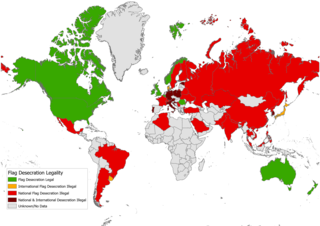
Flag desecration is the desecration of a flag, violation of flag protocol, or various acts that intentionally destroy, damage, or mutilate a flag in public. In the case of a national flag, such action is often intended to make a political point against a country or its policies. Some countries have laws forbidding methods of destruction or forbidding particular uses ; such laws may distinguish between desecration of the country's own national flag and flags of other countries. Some countries have also banned the desecration of all types of flags from inside the country to other country flags.
Texas v. Johnson, 491 U.S. 397 (1989), was a landmark decision of the Supreme Court of the United States in which the Court held, 5–4, that burning the American flag was protected speech under the First Amendment to the Constitution, as doing so counts as symbolic speech and political speech. In the case, activist Gregory Lee Johnson was convicted for burning an American flag during a protest outside the 1984 Republican National Convention in Dallas, Texas, and was fined $2,000 and sentenced to one year in jail in accordance with Texas law. Justice William Brennan wrote for the five-justice majority that Johnson's flag burning was protected under the freedom of speech, and therefore the state could not censor Johnson nor punish him for his actions.
Symbolic speech is a legal term in United States law used to describe actions that purposefully and discernibly convey a particular message or statement to those viewing it. Symbolic speech is recognized as being protected under the First Amendment as a form of speech, but this is not expressly written as such in the document. One possible explanation as to why the Framers did not address this issue in the Bill of Rights is because the primary forms for both political debate and protest in their time were verbal expression and published word, and they may have been unaware of the possibility of future people using non-verbal expression. Symbolic speech is distinguished from pure speech, which is the communication of ideas through spoken or written words or through conduct limited in form to that necessary to convey the idea.
United States v. O'Brien, 391 U.S. 367 (1968), was a landmark decision of the US Supreme Court ruling that a criminal prohibition against burning a draft card did not violate the First Amendment's guarantee of free speech. Though the court recognized that O'Brien's conduct was expressive as a protest against the Vietnam War, it considered the law justified by a significant government interest unrelated to the suppression of speech and was tailored towards that end.
The Revolutionary Communist Youth Brigade (RCYB) was the former youth group of the Revolutionary Communist Party, USA.

The 1984 Republican National Convention convened on August 20 to August 23, 1984, at Dallas Convention Center in downtown Dallas, Texas. The convention nominated President Ronald W. Reagan and Vice President George H. W. Bush for reelection.

Reacting to protests during the Vietnam War era, the United States 90th Congress enacted Public Law 90-381, later codified as 18 U.S.C. 700, et. seq., and better known as the Flag Protection Act of 1968. It was an expansion to nationwide applicability of a 1947 law previously restricted only to the District of Columbia.
Virginia v. Black, 538 U.S. 343 (2003), was a landmark decision of the Supreme Court of the United States in which the Court held, 5–4, that any state statute banning cross burning on the basis that it constitutes prima facie evidence of intent to intimidate is a violation of the First Amendment to the Constitution. Such a provision, the Court argued, blurs the distinction between proscribable "threats of intimidation" and the Ku Klux Klan's protected "messages of shared ideology". In the case, three defendants were convicted in two separate cases of violating a Virginia statute against cross burning. However, cross-burning can be a criminal offense if the intent to intimidate is proven. It was argued by former Solicitor General of Virginia, William Hurd.

Anti-patriotism is the ideology that opposes patriotism; it usually refers to those with cosmopolitan views and is usually of an internationalist and anti-nationalist nature as well. Normally, anti-patriotism stems from the belief that patriotism is wrong since people born in a country, whether they like it or not and regardless of their individuality, are encouraged to love the country or sacrifice themselves for it; consequently, people who oppose patriotism may oppose its perceived authoritarianism, while others may believe that patriotism may lead to war because of geopolitical disputes. Usually, this term is used in a pejorative way by those who defend patriotism or nationalism, and terms such as cosmopolitanism or world citizenship may be used to avoid the bias that comes from the typical usage of the words anti-nationalism or anti-nationalist. The idea of multiple cultures intertwined has also been questioned as anti-patriotic, but mainly in smaller social communities: colleges, universities, etc. The Espionage Act of 1917 and the Sedition Act of 1918 were pieces of legislation in the United States that were passed after it entered World War I, to incriminate individuals who attempted to impede the war effort. Those who did so were punished and believed to be performing acts of anti-patriotism.

Scott Tyler, known professionally as Dread Scott, is an American artist whose works, often participatory in nature, focus on the experience of African Americans in the contemporary United States. His first major work, What Is the Proper Way to Display a U.S. Flag (1989), was at the center of a controversy regarding whether his piece resulted in desecration of the American flag. Scott would later be one of the defendants in United States v. Eichman, a Supreme Court case in which it was eventually decided that federal laws banning flag desecration were unconstitutional.
The following is a timeline of the flag of the United States.

The Flag Protection Act of 2005 was a proposed United States federal law introduced in the United States Senate at the 109th United States Congress on October 24, 2005, by Senator Bob Bennett (R-Utah) and co-sponsored by Senator Hillary Clinton (D-N.Y.). Later co-sponsors included Barbara Boxer (D-Calif.), Mark Pryor (D-Ark.) and Thomas Carper (D-Del.).
Street v. New York, 394 U.S. 576 (1969), was a United States Supreme Court case in which the Court held that a New York state law making it a crime "publicly [to] mutilate, deface, defile, or defy, trample upon, or cast contempt upon either by words or act [any flag of the United States]" was, in part, unconstitutional because it prohibited speech against the flag. The Court left for a later day the question of whether it is constitutional or unconstitutional to prohibit, without reference to the utterance of words, the burning of the flag.
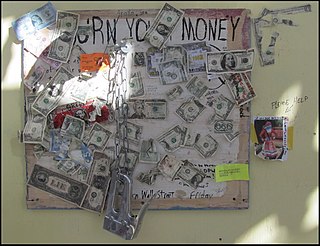
Money burning or burning money is the purposeful act of destroying money. In the prototypical example, banknotes are destroyed by setting them on fire. Burning money decreases the wealth of the owner without directly enriching any particular party. It also reduces the money supply and slows down the inflation rate.
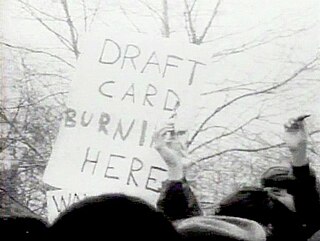
Draft-card burning was a symbol of protest performed by thousands of young men in the United States and Australia in the 1960s and early 1970s. The first draft-card burners were American men taking part in the opposition to United States involvement in the Vietnam War. The first well-publicized protest was in December 1963, with a 22-year old conscientious objector, Eugene Keyes, setting fire to his card on Christmas Day in Champaign, Illinois. In May 1964, a larger demonstration, with about 50 people in Union Square, New York, was organized by the War Resisters League chaired by David McReynolds.
John Mars, known as 2 Black 2 Strong, is an American rapper who recorded in the early 1990s. He is perhaps best known for his song "Burn Baby Burn," about the right to burn the American flag. He led a crew of rappers, MMG, which appeared on many of his tracks.
Spence v. Washington, 418 U.S. 405 (1974), was a United States Supreme Court case dealing with non-verbal free speech and its protections under the First Amendment. The Court, in a per curiam decision, ruled that a Washington state law that banned the display of the American flag adorned with additional decorations was unconstitutional as it violated protected speech. The case established the Spence test that has been used by the judicial system to determine when non-verbal speech may be sufficiently expressive for First Amendment protections.
